Shaw Thing
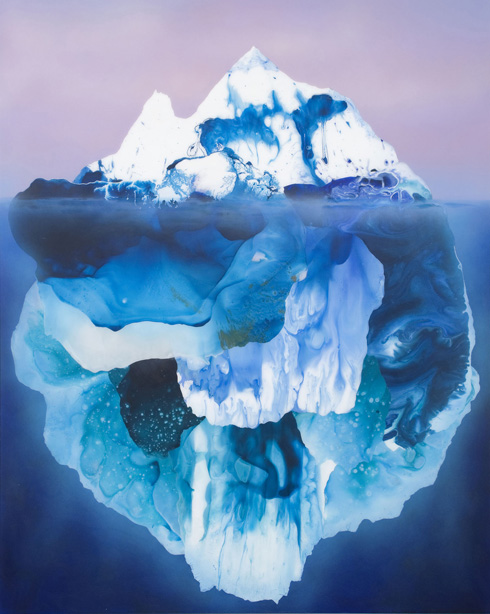
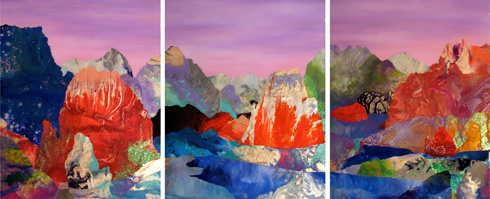
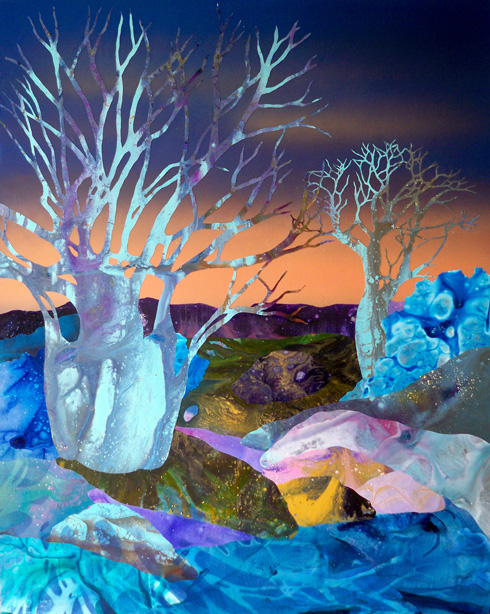
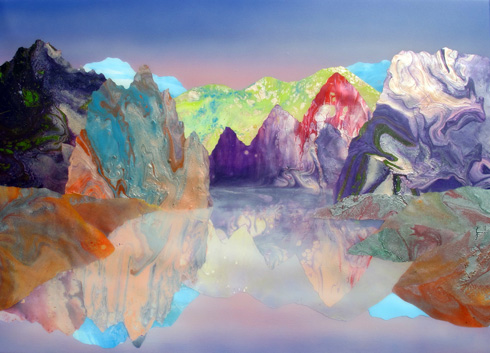
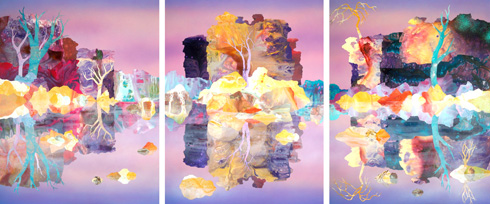
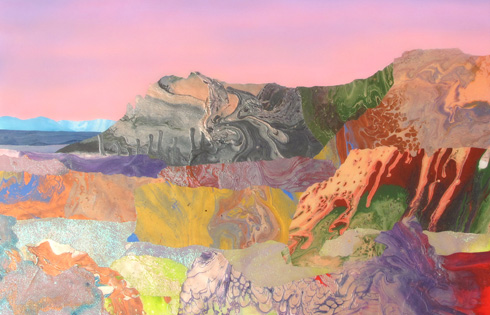 Text: Fleur Mitchell Images: Kate Shaw
Text: Fleur Mitchell Images: Kate Shaw
Kate Shaw’s glacial tripped out landscapes are at once dreamy and disturbing. Pastel pinks swirl organically against acid limes, while a trickle of glitter outlines a slimy green pool. Underneath her work’s innate beauty, lies a more ominous subcurrent. In a way, Shaw’s work is a warning. Her landscapes are concerned with issues of environmental degradation, while tapping into the innate fear and feeling of disconnection we have with the natural world.
Through what she calls ‘paint pours’ and collage techniques using a variety of media, Kate allows her materials to combine with minimal interference to create effects that replicate aspects of the natural world. Her technique also brings into play questions about the nature of painting and forces us to move beyond commonly held assumptions about what a painting should “be”. Skilfully straddling both abstraction and representation, Kate Shaw’s monumental and hallucinogenic works bring into question ideas about how we relate to the natural world, and the state of it.
I spoke to her about her recent exhibition Irrational Geographic at Sullivan & Strumpf in Sydney, place and it’s connection to her practice and what’s in store for the future…
Fleur Mitchell: Where are you currently based?
Kate Shaw: Right now I am in Melbourne but will be back in New York next year.
FM: Did you always know you would be an artist?
KS: Yeah pretty much. I was one of those kids of hippy parents that banned TV and gave us pencils and paper for entertainment so I guess that’s where it all started.
FM: At first glance your work is quite dreamy, meditative and pretty. On further reflection it also has a disturbing element. There is a distinct toxicity to the colours you use and a sinister edge to your landscapes. Are you trying to challenge or comment on how we relate to the natural world and wilderness in modern society?
KS: Yes I am deliberately aiming for a sinister or unnerving element as I think we are quite afraid of nature. The toxicity of the colours is relating to artificiality, pollution and also potential for nature to be unnerving and bizarre. So it’s a tension between the two.
FM: What do you think the future holds for landscape painting?
KS: A lot of work I like is about the environment at large. Julie Mehetru for example makes works that take in amazing architectural cityscapes and maps, layered with abstraction. For me works like this say a lot about the future of the environment at large and through this the landscape.
FM: Tell us about your recent exhibition Irrational Geographic at Sullivan & Strumpf in Sydney, which was absolutely fantastic by the way! What is the general story behind the works in the exhibition?
KS: All the landscapes were inspired from a recent road trip I did through the south west of the United States. The landscape there is mind-blowing, it moves up and down so one minute you are in a snow covered birch forest and the next down the a desert of a canyon. It’s a little like central Australia but in a much more monumental and varied way. So the works I made for Irrational Geographic were whilst I was on a residency at Flu Factory in New York just after I had done this trip. Part of the plan for my residency was to create some video works. So the collage for the large work ‘Projected Futures’ was videoed and that footage was used in the piece called the Spectator.
FM: In your artist’s statement for Irrational Geographic you say that: “my work addresses the tension between abstraction and representation.” What draws you to the fraught relationship between the two?
KS: I have been influenced by the way a painter such as Laura Owens uses various techniques in the ‘vocabulary’ of painting to really making it evident to the viewer that we are ‘completing’ the painting. With my work, areas can be seen on their own as abstraction, i.e.: you can go into one area of the poured work. But then at some point you have to step back and it become something that is recognisable as a landscape.
FM: Irrational Geographic featured a video work that focused on some recent natural disasters. What interests you about these types of disasters?
KS: In that work The Spectator I have used footage from YouTube of people watching icebergs collapse and avalanches that they had taken on there mobile phones or low res video. I have then edited this with my video of the paint moving around. Firstly there was a simple connection between how that moving paint could mimic an avalanche or a lava flow. I was also interested in how people could be that excited about painting. So there is a tension and a humour in these works.
FM: Do you think you will do further video work?
KS: Yes for sure. I aim to continue with the concept of the video playing off the paintings.
FM: Your paintings have such a languid flow to them, as well as a remarkable depth. How do you achieve that amazing marbled effect?
KS: The surface of my paintings is achieved by a variety of collaging and layering techniques. I like that the final surface of the painting is smooth – contradicting the painterly quality of the materials used. This I believe prompts the viewer to ask: what am I looking at? A painting or a digital print? If it is a painting, how is it made…. how does this fit into my language of what a painting is.
FM: Do your materials inform your work or vice versa?
KS: I start my paintings with what I call ‘paint pours’. (I have started becoming interested in the performative and time-based qualities of the pours and have started developing some video pieces). The paint pours comprise of acrylic paint, inks and mediums. I make colour choices and I may move the backing board one-way or another but ultimately the materials move of their own accord. I am fascinated by the way the movement of the paint mimics something from the natural world such as a lava flow, a landslide, an avalanche. Some mediums also react with each other and look like amoeba in a Petri dish or a fern frond unfurling, or a tree branch. From these observations of molecules at play I consider how they may relate to a natural form. Within the dried paint pour I look for something that looks like a tree branch, a cliff or a mountain and then cut and collage the pieces to board. I use airbrush to achieve sky and watery effects and finally resin as a finishing surface. The paintings aim to convey ideas of nature; alchemy and creation by operating on one level as a landscape another as abstraction.
FM: And finally… what’s coming up next for you?
KS: I am in a group show in New York in December this year and I have created projections for the William Jolly Bridge in Brisbane that will be up late December. Next year so far is a solo show at Nellie Castan Gallery, Melbourne in July and Sullivan and Strumpf in Sydney in November.
Kate Shaw
Next story: Sarcastic Disco – DJ Harvey




